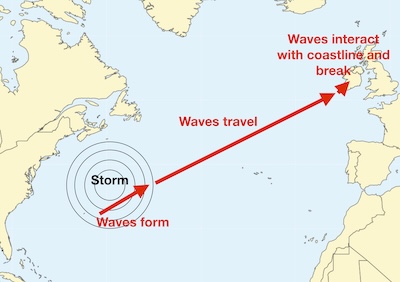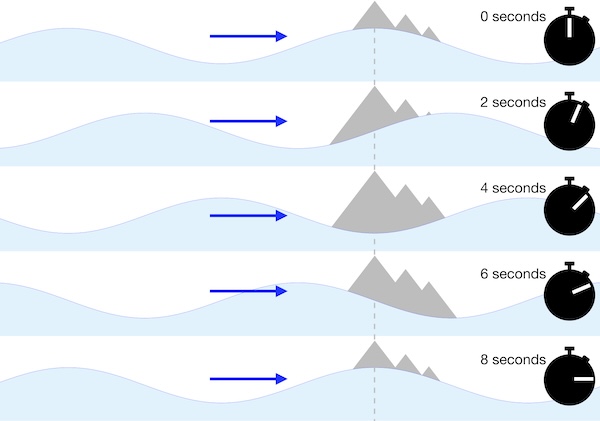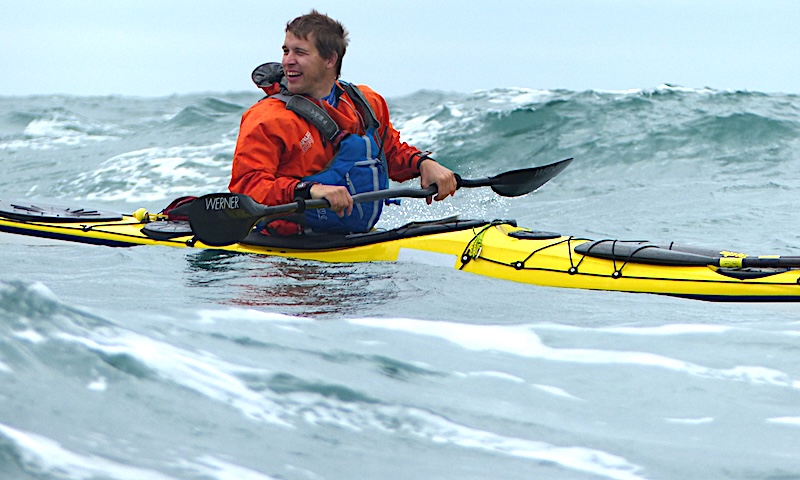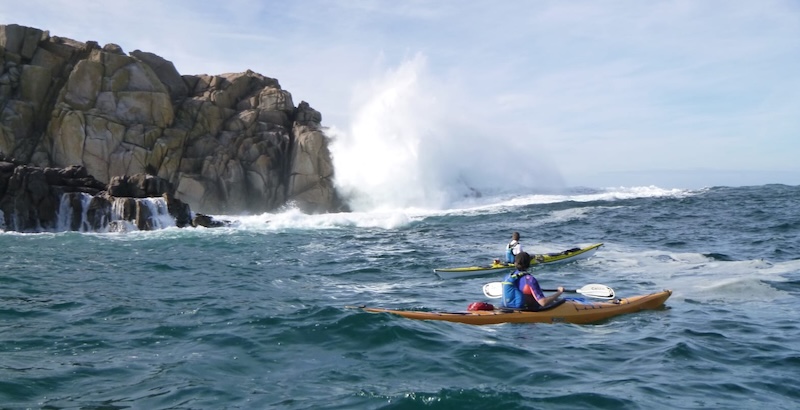Chapter 3 Surf and Swell
3.0.1 The life story of a wave
This section of the notes is about waves. We’ll follow waves from their formation to the point where they break onto a shoreline.

We’ll look at:
Wind waves: waves form when the wind blows across the sea. The processes by which this occurs are remarkably complex - but we’ll be focusing on the results - how the waves produce depend on wind speed and other variables
Ground swell: if there isn’t any land in the way, waves can travel long distances away from the storms that form them. Waves that travel away from the area that they form in are called ‘swell’. We’ll look at what happens as swell travels across oceans
Swell and surf forecasting: where to obtain forecasts of waves and how to interpret them
Waves and topography: what happens when waves enter shallow water and interact with the coastline?
Wind, waves and tidal streams: what happens when waves interact with tidal streams?
Surf: at the end of the wave’s journey it breaks onto a shoreline. How does this happen and how does the quality of the surf depend on the waves and the beach?
3.0.2 Terminology
It’s worth defining a few terms that we use to describe waves. Let’s start with a snapshot of a wave at one moment in time:

The peak (or crest) is the highest point on the wave. The trough is the lowest point.
The vertical distance from trough to peak is the height. Height can be hard to estimate from a kayak. A useful guide is that a kayaker’s eye height is around 1 meter above the water, so if you start to lose sight of the horizon in the trough, the waves are over a meter high.
The wavelength is literally how long the wave is from one peak to the next peak (or, indeed from one trough to the next). Wavelengths vary markedly between waves - a short chop might have a 6 meter wavelength, whereas an ocean swell wavelength might be 350 meters!
Now let’s see what happens as the waves roll past us:

In the diagram, we’re looking at the waves at a few instants in time, separated by 2 seconds. In the top image, we’ve started a stopwatch when the peak of the wave passes a fixed point - the peak of a distant island. 2 seconds later, the waves have moved to the right. We keep timing and notice that 8 seconds later, the peak of the next wave has arrived at our fixed point. We call the time that the waves takes to pass, in this case 8 seconds, the period of the wave. You can measure the period of the waves easily from your kayak by counting the seconds between being on the crests of subsequent waves.
Obviously, the height of waves has a big effect on our experience of kayaking. The period also has a big effect. Short period waves will throw the boat up and down quickly, making for a bumpy ride and making it more difficult to paddle - it’s easy to ‘miss the water’ with a paddle blade in short period waves. By contrast, long period waves tend to make for mellow paddling conditions - the boat gently rises and falls, but the wave isn’t steep. Paddling in a 3 meter swell with a 15 second period can be a very chilled out experience. Paddling in 1 meter waves with a 2 second period is likely to be more challenging (and probably wetter) experience.
You’ll also notice a difference when long and short period waves hit the shoreline and break. Clearly a higher wave will break harder than a short one - a wave that’s twice as high carries 4 times as much energy. But period has an equally big effect - a 10 second period wave carries 4 times as much energy as a 5 second period one. So, if there’s 15 second swell coming into a shoreline, expect big surf and scary rockhopping.

Paddling in short period waves - the waves are not very powerful, but the steepness of the waves is sufficient to make inexperienced paddlers feel unsteady

Paddling in long period swell. The wavelength is many times the length of the kayaks, so these were laid back paddling conditions. However, we’re keeping well away from where the waves are breaking on the headland with incredible force.
Generally, short period waves are caused by local winds - you’ll normally experience them when the wind is blowing. Long period waves are always swell from distant storms. We’ll see why this is when we look at ground swell in more detail.
The speed of the waves is simply the wavelength divided by the period. In deep water, the speed of a wave depends on the wavelength. As a result, for a deep water wave, the wavelength is always 1.56 times the period squared. To save the calculations, here’s some examples:
| Period (seconds) | Wavelength (meters) | Wave speed (knots) | Gradient of 2 m wave |
|---|---|---|---|
| 2 | 6 | 6 | 0.3 |
| 5 | 39 | 15 | 0.05 |
| 8 | 100 | 24 | 0.02 |
| 10 | 156 | 30 | 0.01 |
| 12 | 225 | 36 | 0.009 |
| 15 | 351 | 45 | 0.006 |
| 17 | 451 | 52 | 0.004 |
| 20 | 624 | 61 | 0.003 |
Notice how for a wave of the same height, the wave gradient is many times less for the long period waves.